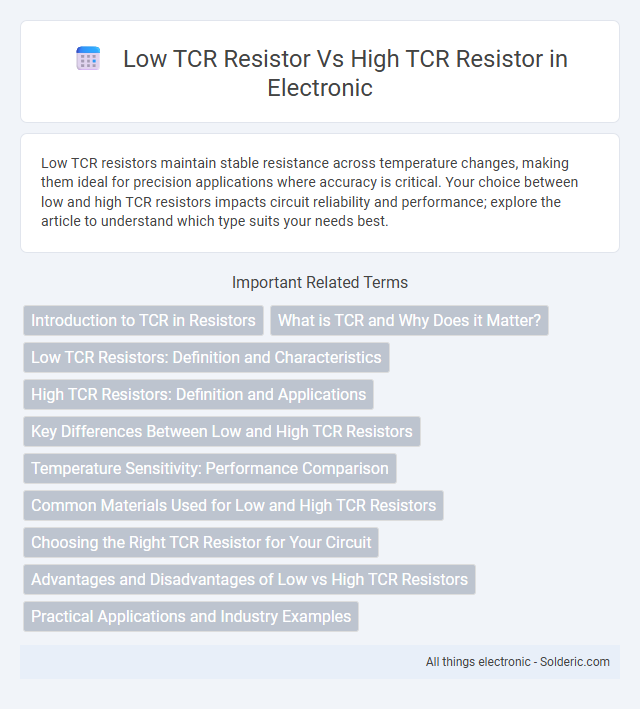Low TCR resistors maintain stable resistance across temperature changes, making them ideal for precision applications where accuracy is critical. Your choice between low and high TCR resistors impacts circuit reliability and performance; explore the article to understand which type suits your needs best.
Comparison Table
| Feature | Low TCR Resistor | High TCR Resistor |
|---|---|---|
| TCR (Temperature Coefficient of Resistance) | Typically 10 ppm/degC or less | Typically above 100 ppm/degC |
| Temperature Stability | Excellent stability; minimal resistance change with temperature | Poor stability; significant resistance variation with temperature |
| Applications | Precision circuits, measurement devices, high accuracy sensors | General-purpose circuits, non-critical applications |
| Cost | Higher cost due to tight tolerance and material quality | Lower cost, widely available |
| Material | Metal film, wirewound resistors | Carbon film, metal oxide resistors |
| Performance Impact | Maintains performance over temperature variations | Performance degrades with temperature fluctuations |
Introduction to TCR in Resistors
Temperature Coefficient of Resistance (TCR) measures how a resistor's resistance value changes with temperature, expressed in parts per million per degree Celsius (ppm/degC). Low TCR resistors exhibit minimal resistance variation, typically below 50 ppm/degC, ensuring stability in precision applications such as instrumentation and aerospace electronics. High TCR resistors, often exceeding 200 ppm/degC, are more cost-effective but less stable, suitable for general-purpose circuits where thermal variation impact is negligible.
What is TCR and Why Does it Matter?
TCR, or Temperature Coefficient of Resistance, measures how a resistor's resistance value changes with temperature fluctuations, expressed in parts per million per degree Celsius (ppm/degC). Low TCR resistors offer greater stability and precision in circuits by minimizing resistance variations, making them essential for sensitive applications like precision instrumentation and medical devices. Your choice between low and high TCR resistors impacts accuracy, with high TCR resistors exhibiting larger resistance shifts that can compromise performance in temperature-sensitive environments.
Low TCR Resistors: Definition and Characteristics
Low TCR resistors exhibit minimal resistance changes with temperature fluctuations, typically measured in parts per million per degree Celsius (ppm/degC), making them ideal for precision applications. Their stable resistance ensures high accuracy and reliability in circuits sensitive to thermal variations, such as instrumentation and measurement devices. You benefit from enhanced performance and consistent results by selecting low TCR resistors where temperature stability is critical.
High TCR Resistors: Definition and Applications
High TCR (Temperature Coefficient of Resistance) resistors exhibit significant resistance changes with temperature variations, making them suitable for temperature sensing and compensation applications. Their sensitivity to temperature enables precise measurement and control in environments where thermal fluctuation impacts performance. You can find high TCR resistors commonly used in circuits requiring accurate thermal feedback, such as thermostats and temperature sensors.
Key Differences Between Low and High TCR Resistors
Low TCR (Temperature Coefficient of Resistance) resistors maintain stable resistance values under temperature changes, making them ideal for precision circuits requiring minimal resistance variation. High TCR resistors, conversely, exhibit significant resistance fluctuations with temperature shifts, suitable for applications where temperature sensing or compensation is needed. Understanding your circuit's temperature sensitivity will help determine whether a low or high TCR resistor best meets your accuracy and performance needs.
Temperature Sensitivity: Performance Comparison
Low TCR resistors exhibit minimal resistance variation with temperature changes, providing stable and precise performance in temperature-sensitive applications. High TCR resistors experience significant resistance shifts as temperature fluctuates, which can lead to inaccurate measurements and reduced circuit reliability. Your choice of resistor impacts overall accuracy, making low TCR resistors ideal for precision electronics demanding consistent temperature stability.
Common Materials Used for Low and High TCR Resistors
Low TCR resistors commonly use materials like metal foil, metal film, and certain composites designed for minimal resistance change with temperature fluctuations, ensuring precision in sensitive applications. High TCR resistors typically employ carbon composition or thick film materials that exhibit more significant resistance variation due to temperature changes, often suitable for circuit protection or compensation roles. Your choice depends on the required temperature stability, with metal foil offering the lowest TCR and carbon composition providing higher TCR characteristics.
Choosing the Right TCR Resistor for Your Circuit
Selecting the right TCR (Temperature Coefficient of Resistance) resistor depends on your circuit's sensitivity to temperature variations; low TCR resistors, with values typically below 50 ppm/degC, maintain stable resistance and ensure precision in measurement and control applications. High TCR resistors, often exceeding 200 ppm/degC, can cause significant resistance changes with temperature, making them suitable for applications where temperature sensing or compensation is required. Your choice should balance accuracy needs and environmental conditions to optimize circuit performance and reliability.
Advantages and Disadvantages of Low vs High TCR Resistors
Low TCR resistors offer superior stability and precision in temperature-sensitive applications by minimizing resistance variation with temperature changes, making them ideal for accurate measurements and high-quality electronics. High TCR resistors tend to be less expensive and suitable for applications where precise resistance stability is not critical, but their resistance fluctuates significantly with temperature, potentially impacting circuit performance. When selecting resistors, consider that using low TCR resistors can enhance your device's reliability and accuracy, especially in environments with varying temperatures.
Practical Applications and Industry Examples
Low TCR resistors, exhibiting minimal resistance change with temperature variation, are essential in precision electronics such as aerospace avionics and medical devices where stability ensures accurate measurements and performance reliability. High TCR resistors, which have a greater resistance change with temperature, find practical applications in temperature sensing circuits and compensating devices in HVAC systems and automotive sensors. Your choice between low and high TCR resistors directly impacts the efficiency and accuracy of critical industrial applications, influencing long-term operational stability.
low TCR resistor vs high TCR resistor Infographic

 solderic.com
solderic.com